IWC Schaffhausen
Flying High With IWC
This is a realization that I made when I saw the IWC Pilot Mark XV for the first time, and how I saw it illustrates the effect of a successful design, that when done right, can inspire admiration, love and respect. It was the briefest of glimpses in the movie Vanilla Sky, starring Tom Cruise, when in an opening scene, he wakes up, reaches to his side table and pulls his money clip, ID, and a beautiful watch towards him, getting ready to go out the door.
In that brief moment, I saw it well, and the image of the watch was forever burned into my consciousness. Even in that fleeting glimpse, I had been able to make out the distinctive upward-pointing triangle at 12 o’clock and black dial, and I was mesmerized. What was this watch, I wondered, so clear in its intention, yet so beautiful in its simplicity? I remembered freeze-framing that scene countless times to try to identify it, and it was this process that started for me, an obsession with the Pilot’s watches from IWC.
Here was a watch that had everything a watch should have. It had a round stainless-steel case, supple leather strap and held the essential information of the time and date, all told with white markings against an immensely readable black dial, with that triangle at 12 o’clock orienting the right direction to read the watch. Even disregarding its pilot heritage, this was how the prototypical watch of my imagination should be: functional, usable, beautiful and simple. How amazing it is then when a few basic ingredients put together in just the right way could create an impression of a lifetime.

On Pier: IWC Big Pilot’s Heritage Watch 48 in titanium with brown calfskin strap. Brown genuine-leather jacket, Schott NYC; White cotton shirt, navy silk-knit tie and black leather gloves, all property of Revolution On Nikayla: IWC Pilot’s Watch Automatic 36 in stainless steel with dark-brown alligator-leather strap. Black leather-polyester jacket, white viscose shirt, and black calfskin-leather trousers, all property of Revolution
And while many brands have taken these essential ingredients and made their own versions; for many people, only a Pilot’s watch from IWC stands at the pinnacle. Indeed the historical legitimacy of IWC in this arena is unrivalled, marked not just for the innovations that the brand has brought forward in the service of aviation, but also in the length of military service and variety of Pilot’s watches brought out since the very first issue in 1936.
This year, in 2016, the Pilot collection from IWC has been renewed in every single one of its four pillars — the Classics, the TOP GUN Miramar, the “Antoine de Saint Exupéry” and “Le Petit Prince”, and the Spitfire — with the unique characteristics of each pillar, ranging from the historical, to the whimsical to the modern, promising something for every shade of enthusiast for the Pilot watch.
Classics Collection: The Historical Connection
Amazingly, the historical legitimacy embodied in any pilot’s watch from IWC, comes from only three watches. It is in these three watches that everything we see today in the collection can be understood. They were the first “Special Pilot’s Watch” of 1936, the iconic B-Uhr, shortened from its full name “Beobachtungs-Uhren” (or Observation Watch, translated from German) of 1940, and the legendary Mark 11 from 1948 commissioned and used by the British Royal Air Force.
These watches were significant for bringing new features to the pioneers of aviation, coming with extreme legibility as a first requirement, then taking on various technical characteristics as the technology of aviation became better understood. These ranged from the utilization of an anti-magnetic escapement for the first IWC Pilot’s watch in 1936, to ever-greater levels of temperature-, vibration- and shock resistance in the later watches. The Mark 11, for example, was the first Pilot’s watch to come with a soft-iron cover for the movement, promising protection from the greater levels of magnetism that came as cockpits became more advanced.
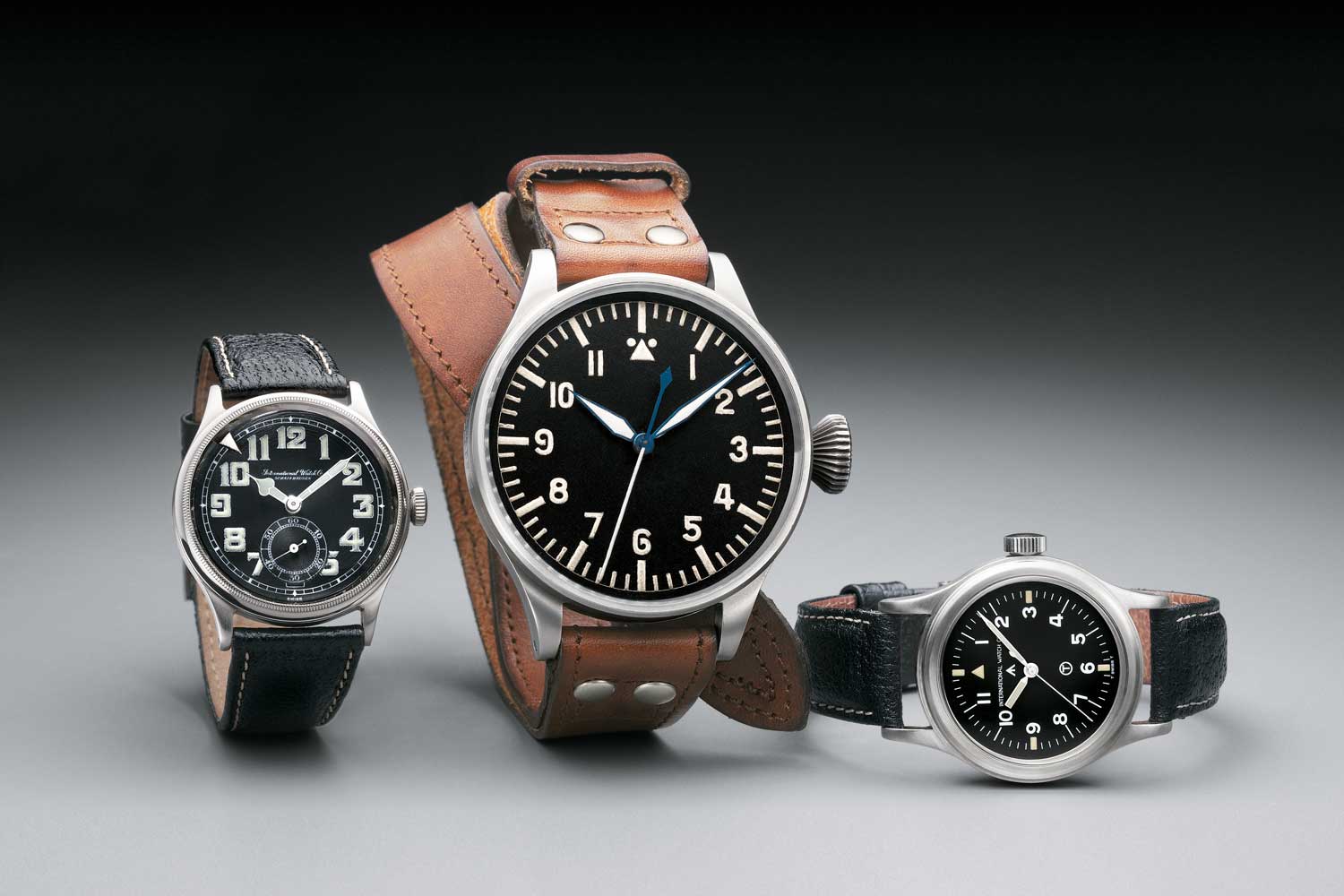
These watches form the foundation for every IWC Pilot Watch today. (from left to right): The “Special Pilot’s Watch of 1936; the iconic B-Uhr, shortened from its full name “Beobachtungs-Uhren” of 1940; the legendary Mark 11 from 1948 commissioned and used by the British Royal Air Force
The abundant aviation heritage of IWC is perhaps most evident in its star watches this year — a pair of Big Pilots that have taken the original B-Uhr of 1940 as their direct inspiration.
Indeed the first of the modern Big Pilot line came in 2002, with the 46mm IWC Big Pilot ref. 5002, which was then updated slightly again in the ref. 5004 with a more-modern, less military-oriented design. The watches were a sensation when they first appeared, being very handsome watches that sat well on the wrist, in a way that epitomized the legibility requirements of its heritage, with a wrist presence that many would come to love. Having grown to become a staple product in the range of Pilot’s watches from IWC, the basic ingredient of a large uncompromising case has inspired many variants, allowing collectors to experience different possibilities of its design.
And yet, what if you wanted a Big Pilot watch that was a little closer aesthetically to the original B-Uhr? Well, you would only have to look at what IWC has come up with this year in 2016 — two watches that not only offer this trait, but also straddle a modern watch wearer’s twin requirements of practicality and historical legitimacy.
The Heritage 55 and 48 come in 55mm and 48mm cases respectively, and give collectors a chance to wear something that might have been used by real pilots in the past. Indeed, if the 55mm case of the original B-Uhr is something that you would like to experience, there is no better proxy than the Big Pilot Heritage 55. This is the perfect modern B-Uhr as it takes the aesthetics of the original, save for slight differences in the font used (see the closed “9” versus the open “9” in the original) in a watch of the same size, with the notable difference being its thinner (the original was 13.5mm thick) and lighter titanium case.
In addition, the movement, in keeping with its aesthetics is decidedly more traditional than one might expect from a modern watch, being the IWC cal. 98300, a derivation of a pocket-watch movement that was designed under IWC’s founder, Florentine Ariosto Jones. With a beat rate of 18,000vph and a 48-hour power reserve and being hand-wound, this is a movement that is certainly in line with the mood of a time that the watch is intended to evoke. Indeed the main difference in using a movement like this, which deviates from the original B-Uhr, is the lack of the large central seconds hand. In its place for the Big Pilot Heritage 55, we have the small seconds in a subdial at six o’clock.
The Big Pilot Heritage 55 is certainly a special watch, and will definitely find fans that can appreciate what it is all about. Yet it is not a practical watch for everyday wear, being a little too large, just like the original, for anything more than a specialized intention. For something that one could conceivably use every day, however, just like the modern Big Pilots, it is the Big Pilot Heritage 48 that would suit better.
With almost similar aesthetics to the Big Pilot Heritage 55, the Big Pilot Heritage 48 reveals its more-wearable intent in the choice of the movement it uses and the features that it makes possible. Housed in a smaller titanium case at 48mm wide, this watch uses the IWC cal. 59215, the same movement found in the Portugieser Hand-Wound Eight Days, with very different technical abilities from the old-school movement found in the Heritage 55. Beating at a faster and more-modern speed of 28,800vph, this movement allows an eight-day power reserve and a date function that appears in the six o’clock subdial.
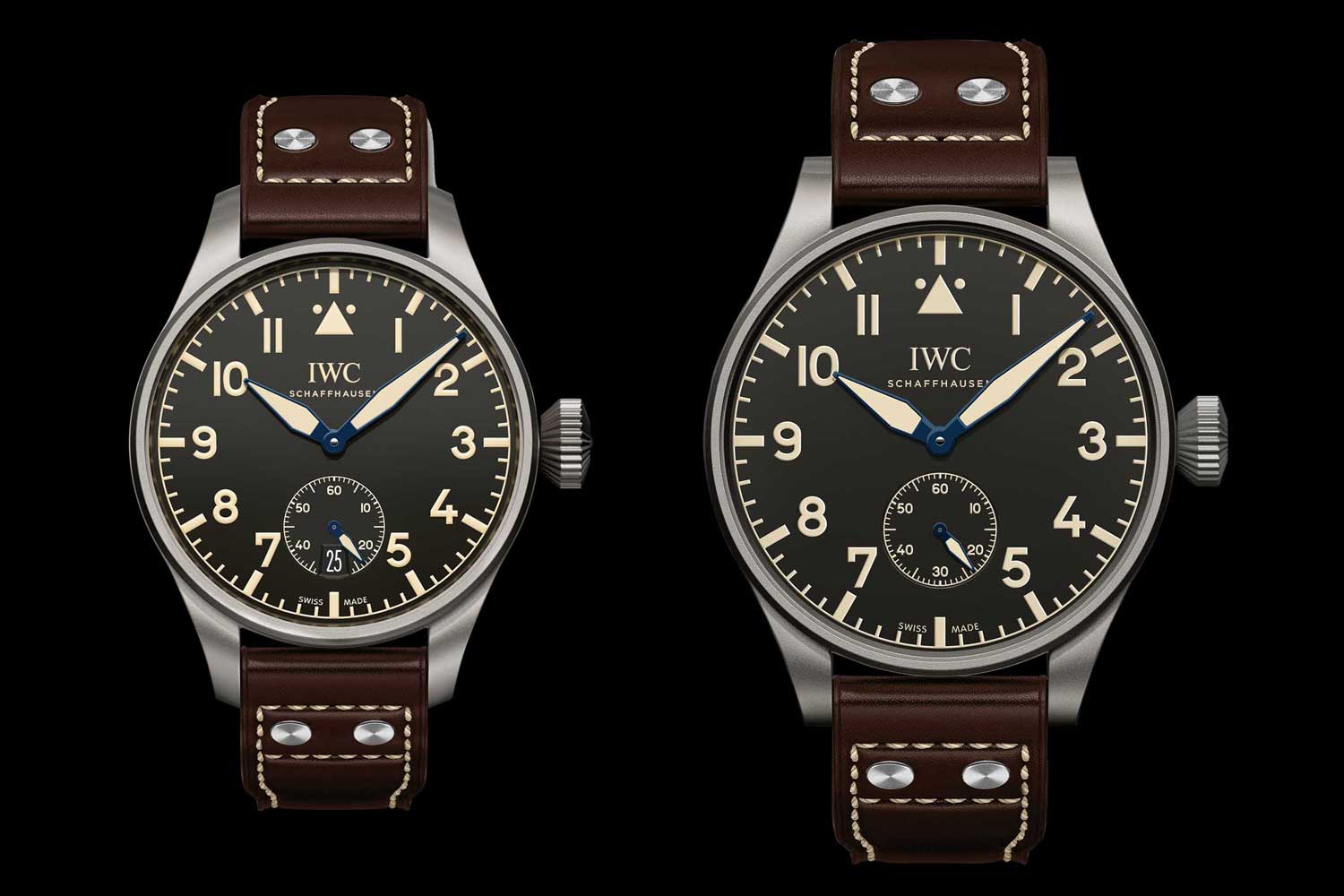
The Big Pilot Heritage 48 (left) and Big Pilot Heritage 55 (right) are the modern incarnations of the legendary B-Uhr watch produced in 1940 for the German Airforce
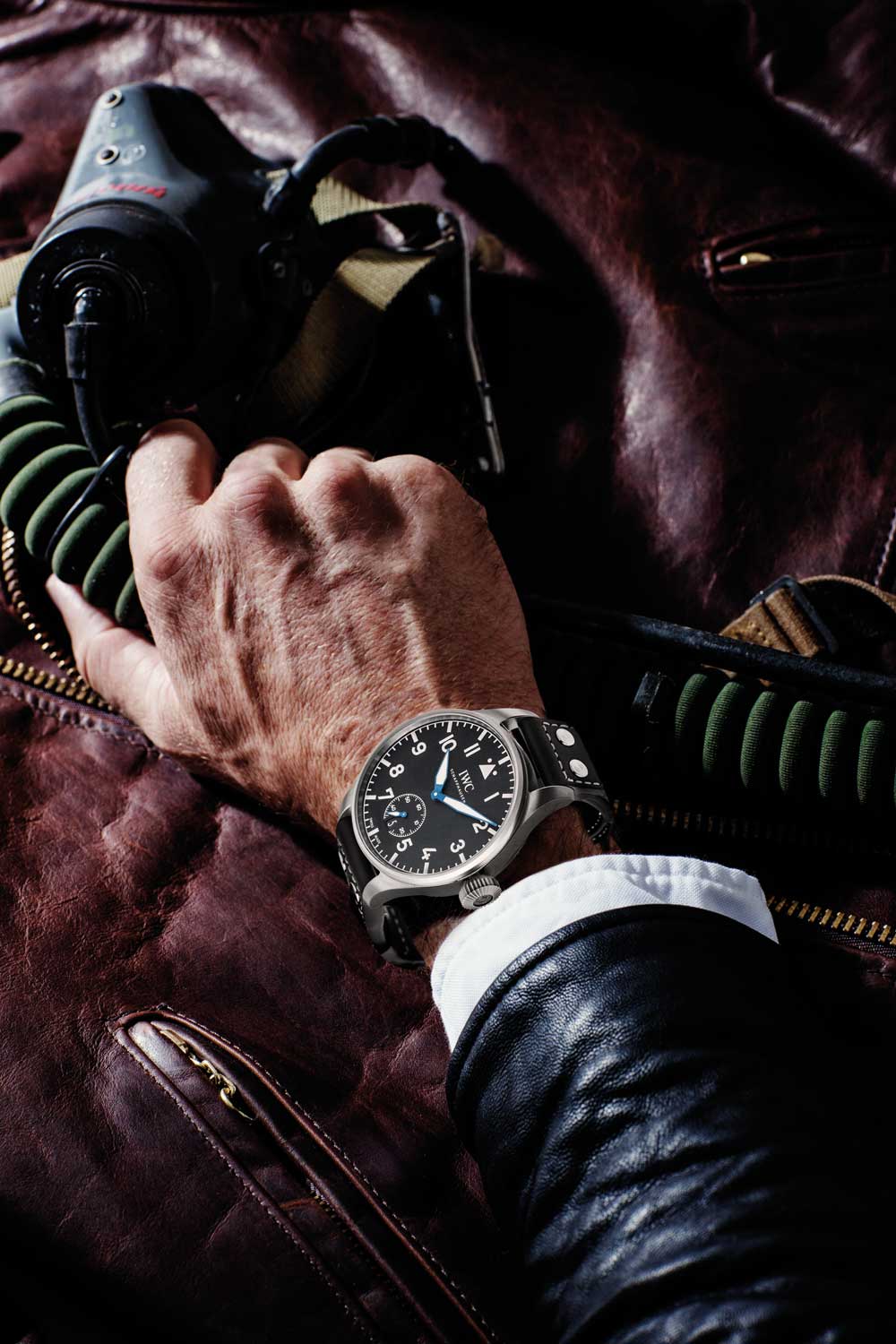
IWC Big Pilot’s Heritage Watch 48 in titanium with brown calfskin strap
Certainly then, with the special nature of both these watches, it comes as no surprise that they are both limited editions. The Big Pilot Heritage 55 is limited to 100 pieces, while the Big Pilot Heritage 48, perhaps to reference the total number of IWC B-Uhr watches ever made, is limited to 1,000 pieces.
The second biggest launch this year for 2016, comes in the form of the Mark XVIII, the latest member of the legendary Mark series. In modern times, it has taken a place as the entry-level pilot’s watch for IWC, becoming popular not just for its affordability but also for its place in being descended from the legendary Mark 11. Its place in the collection has allowed many converts to the brand to have in one watch, everything that IWC represents in the world of aviation.
Indeed, what’s significant about the Mark XVIII this year is how it gives lovers of the Mark series, a new basic watch that simplifies the date aperture of the previous Mark XVII at a smaller size of 40mm (compared to the 41mm diameter of the previous Mark XVII), a more-convenient watch to wear every day.
Indeed one of the reasons why the Mark XVIII of 2016 is so important is because it is the latest member of a line that a great number of watch lovers are interested in. Whenever a new version appears, it is in the details that watch lovers look to, to approve or to criticize. In this instance, the Mark XVIII has got everyone very excited for the way it has managed to simplify and return a well-loved watch to its origins in a clearer way.
In this latest version, the controversial triple-date aperture window, loved and hated in equal measure by watch fans, has been changed to a single-line date window. Certainly, while the triple-date aperture window was a functional design that allowed the reading of the date when the hands covered any one of the exposed numerals, and further, had been inspired by cockpit instrumentation, there were watch fans who did not like it as it took too much space on the dial. This new single line takes a more-traditional look, and has the advantage of being cleaner in feel. In addition, the numeral “9”, previously done away with in the mark XVII has been brought back, and the position of the triangle with two dots has brought down lower on the dial, much like the Mark XV.
Elsewhere in the Classics pillar, we find the same design considerations extended to two well-loved staples of the line, the Pilot Chronograph (IW377709) and the standard Big Pilot (IW500912). Like the aforementioned Mark XVIII, the triple-date aperture, which was a design feature in the previous Pilot Chronograph ref. 3777, has now been reduced to a single line in this year’s version, bringing it in line with the older Pilot Chronograph ref. 3717 that was well loved in collector circles. Essentially, the new Pilot Chronograph of 2016 takes the best attributes from the previous two versions, the single-line day/date indication and the bigger size of 43mm, and brings it together into one watch.
In addition, the standard Big Pilot that we know has been updated with a slight facelift — most significantly, modifying the size and position of the Arabic numerals to make space for the numeral “9” that had previously been omitted. This adjustment, as with the position of the triangle at 12 o’clock, now brought to a lower position, brings the look of the Big Pilot in line with the original B-Uhr as well as the two limited-edition Big Pilot Heritage models.
In keeping with the range of choices in the Classics pillar, the Pilot’s range sees, as well, a new model based on the Mark XVIII, now sized at 36mm. Keeping to the same size as the legendary Mark 11, the new Pilot’s Automatic Watch 36 is the smallest watch on offer in the collection and has the potential to appeal to those wanting a more vintage correct case size, or men and women with smaller wrists. Slightly dressier in the details, (note the recessed circle inside the minute track) and coming in a range of dial colors and variations on bracelet and Santoni leather straps, this simplified version of the IWC Pilot’s Watch has all the right ingredients for broad and lasting appeal.
Lastly, to round out the Classics pillar, comes a watch that breaks new ground in the technical capabilities expressed by the Pilot range. The technically brilliant Pilot’s Watch Timezoner Chronograph (IW395001), while not having the traditional aesthetics of the range, comes with a never-before-seen complication that allows time zones to be quickly changed via a unique mechanism. By turning the bezel to find the reference city that you want at the 12 o’clock position, the hour hand and the red 24-hour hand (acting as a day/night indicator) move into position to show the correct time there. Coming with a chronograph, this unique watch is definately something that a pilot will find useful and convenient.
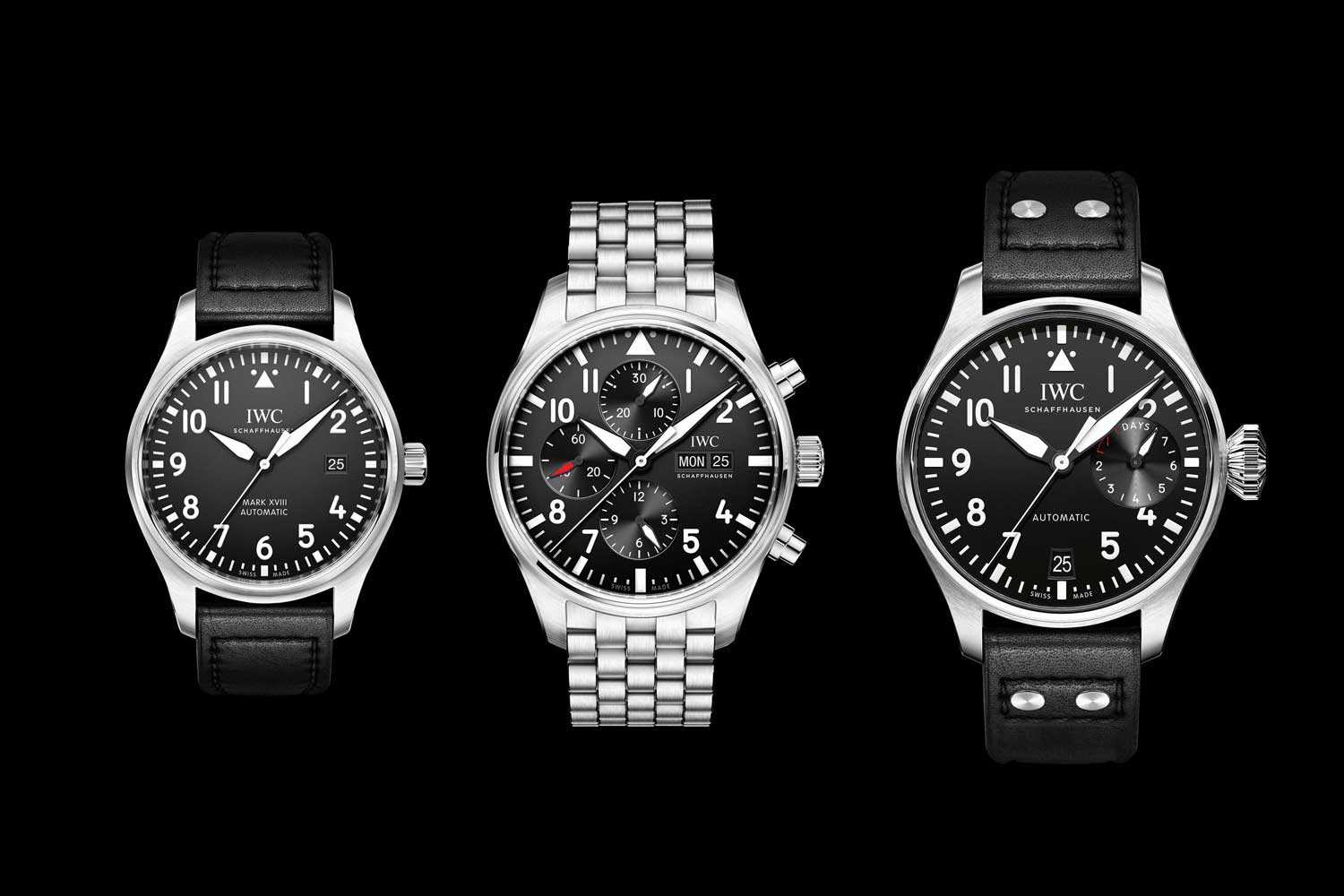
The new models of the Classics Pillar: (from left) the Mark XVIII, Pilot’s Watch Chronograph and Big Pilot are updated versions of well-loved staples of the collection, coming with design tweaks for a more elegant presentation

IWC Pilot’s Watch Timezoner Chronograph in stainless steel with black and gray twin-colored textile strap. Brown genuine-leather jacket, Schott NYC; white cotton shirt, black cotton-elastane jeans, navy silk-knit tie and brown leather belt, all property of Revolution
Top Gun: Watches for the Jet Age
The most-modern expression of the IWC Pilot’s range is easily the Top Gun collection, the youngest pillar of the range that attained this status in 2012, the last year in which the Pilot’s range was the brand’s focus. Characterized by a sleek and modern character, epitomized by the iconic fighter jet, the Grumman F-14 Tomcat, the plane of choice for the United States Navy Fighter Weapons School located in Miramar, San Diego, the range of watches takes its name from the popular nickname of the “United States Navy Strike Fighter Tactics Instructor Program” of SFTI, also known as “TOP GUN”.
The most obvious way that one distinguishes a member of the TOP GUN collection is that most of the watches that bear this designation are encased in scratch-resistant ceramic. And like the other pillars presented this year, the latest members of the TOP GUN family have also undergone a series of design tweaks aimed at bringing out a more-elegant character to the range.
The first, the Pilot’s Watch Chronograph TOP GUN Miramar (IW389002) now comes in a smaller 44mm case, 2mm down from the previous version, and also comes modified to have a single-line date day window as with the standard Classic Pilot’s Watch Chronograph. The combined hour-and-minute counter at 12 o’clock remains the same, as does the flyback-chronograph function from the previous version.
The totally new Mark XVIII TOP GUN Miramar (IW324702), as well, is a welcome member to this family, coming in a ceramic case at a size of 41mm, 1mm bigger than the standard Mark XVIII, and taking the inspiration of the original Mark series from the days of the observer watch, into the modern jet-fighter era.
Lastly, there is the Big Pilot’s Watch TOP GUN (which now comes in a smaller 46mm, as opposed to the previous version at 48mm), which rounds up a trio of the latest TOP GUN watches.
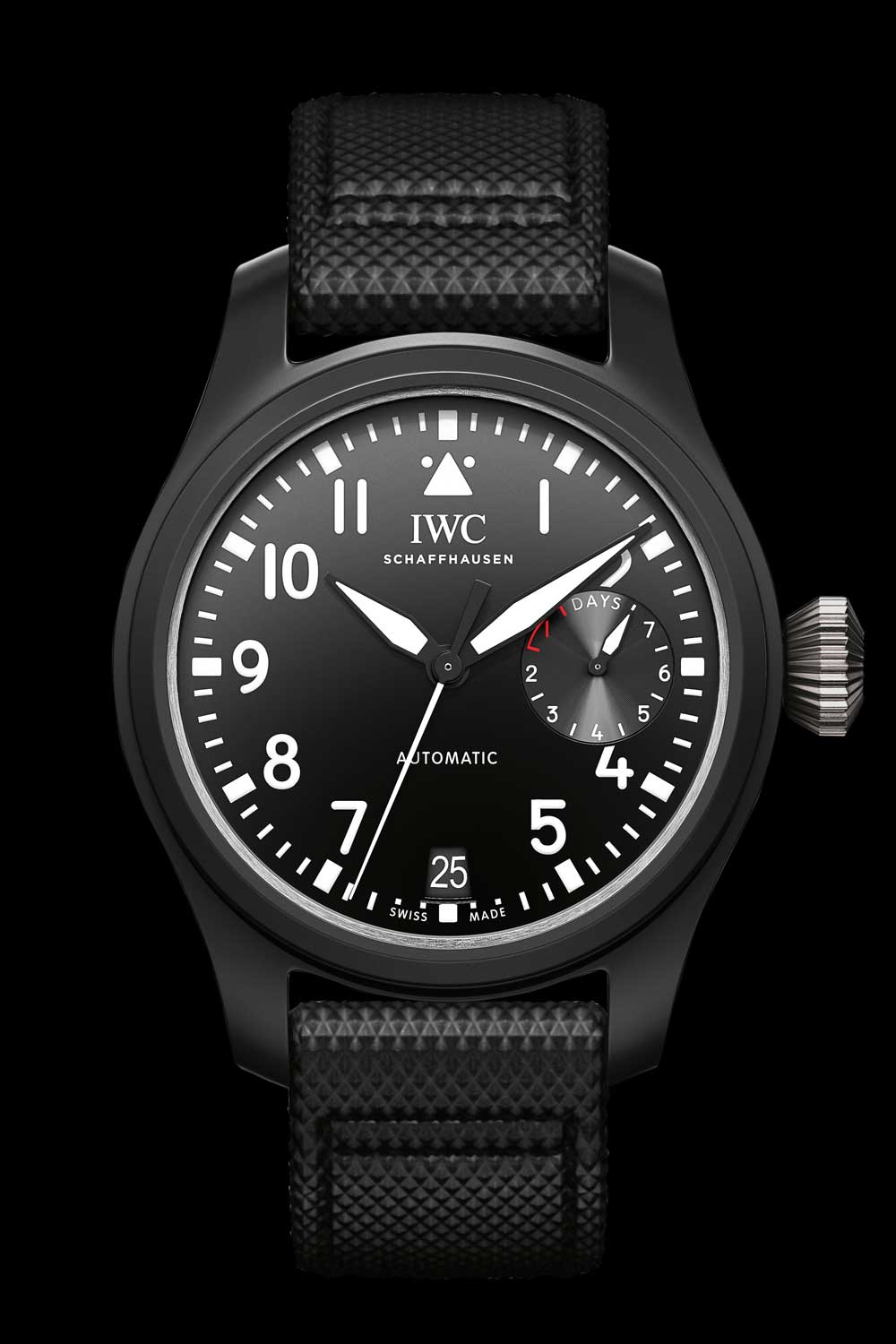
The new IWC Big Pilot’s Watch TOP GUN in black ceramic is now 46mm in diameter, down 2mm from the previous version, but still as legible as ever
“Le Petit Prince” and the whimsical world of “Antoine de Saint Exupéry”
French pilot, writer, poet and pioneering aviator Antoine de Saint Exupéry is perhaps best known for being the author of one of the most popular children’s books ever published — Le Petit Prince, the fourth most translated book of all time, and a whimsical, philosophical tale of a pilot who meets a mysterious prince from a faraway asteroid after crashing in the desert. Told in an autobiographical way, and influenced by de Saint Exupéry’s personal experience of crashing in the Sahara, the book is a literary masterpiece that has resonated through time, containing timeless lessons on life, death and relationships.
Indeed, such is the enduring power of this classic tale, that when IWC began collaborating with the Antoine de Saint Exupéry Youth Foundation in 2006, and started releasing the first “Little Prince” watches, the line instantly became very popular, and one of the most successful. It’s not difficult to see why, for while the Classics pillar is the bread and butter of the range that expresses aviation in its purest form, it is for the more whimsical among us who, in taking pleasure in the possibilities offered by the dream of flight, would likely prefer the “Le Petit Prince” range for the additional association with a literary masterpiece by an accomplished aviator.
The extension of the “Le Petit Prince” pillar continues this year with the highlight piece of the collection, the 250-piece limited-edition Big Pilot’s Watch Annual Calendar Edition “Le Petit Prince” (IW502701) in luxurious red gold, using the technically brilliant cal. 52850 first seen last year. The most charming feature of this watch can seen in the sapphire caseback — the solid-gold rotor formed in the famous image of the little prince standing on his tiny asteroid, which appears on the cover of the book.
Further adding to the “Le Petit Prince” collections as well, are three Pilot’s Watches with the signature midnight-blue dial of the limited-edition “Le Petit Prince”: the Big Pilot’s Watch (IW500916), the Pilot’s Watch Chronograph (IW377714) and the Pilot’s Watch Mark XVIII (IW327004). These have been updated, dial wise, to the same design codes of the standard versions, differing only in the engraving of the caseback, showing the Little Prince in his coat and holding his sword.
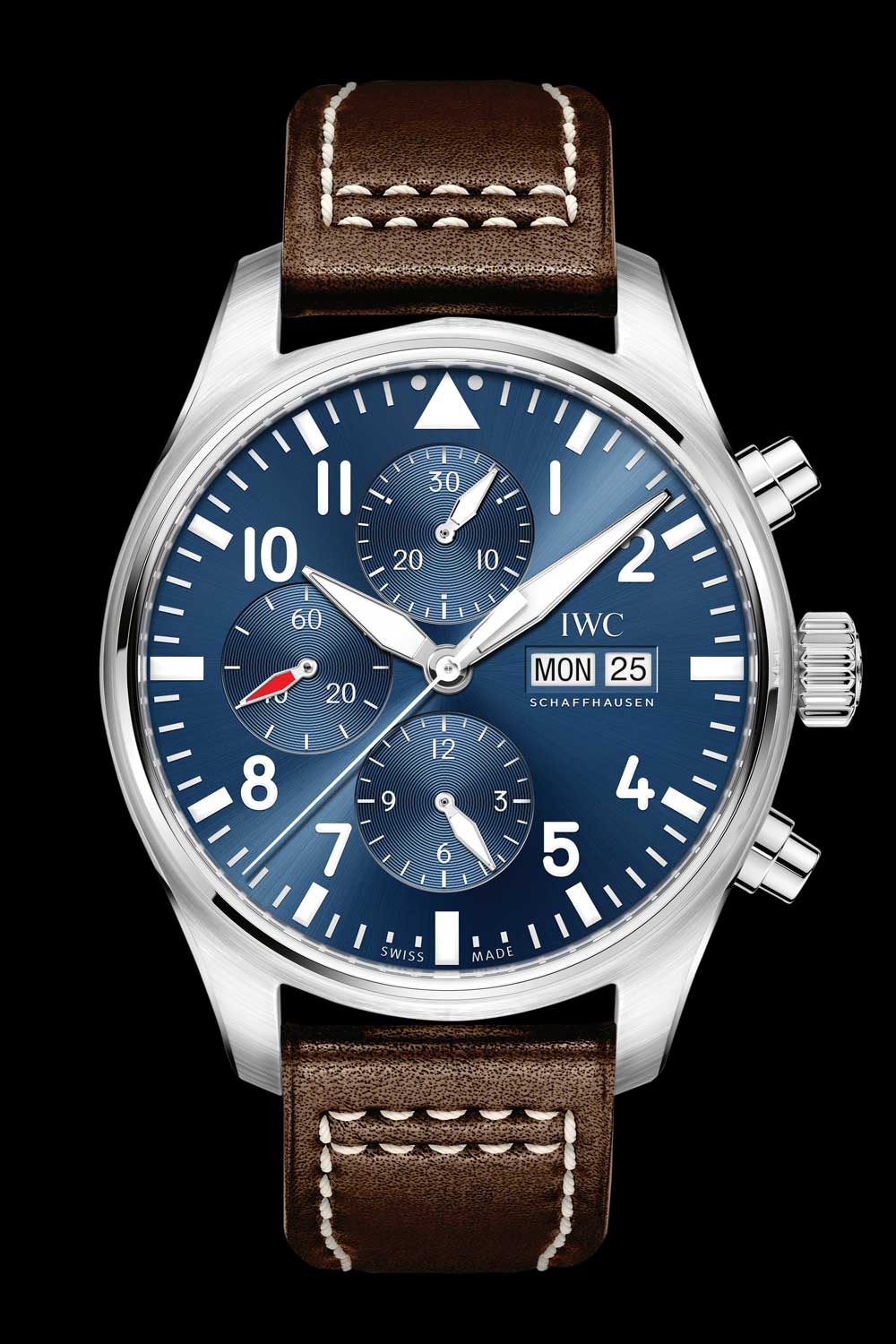
The signature midnight-blue dials of the “Le Petit Prince” collection can be seen in this trio of watches released for this year.
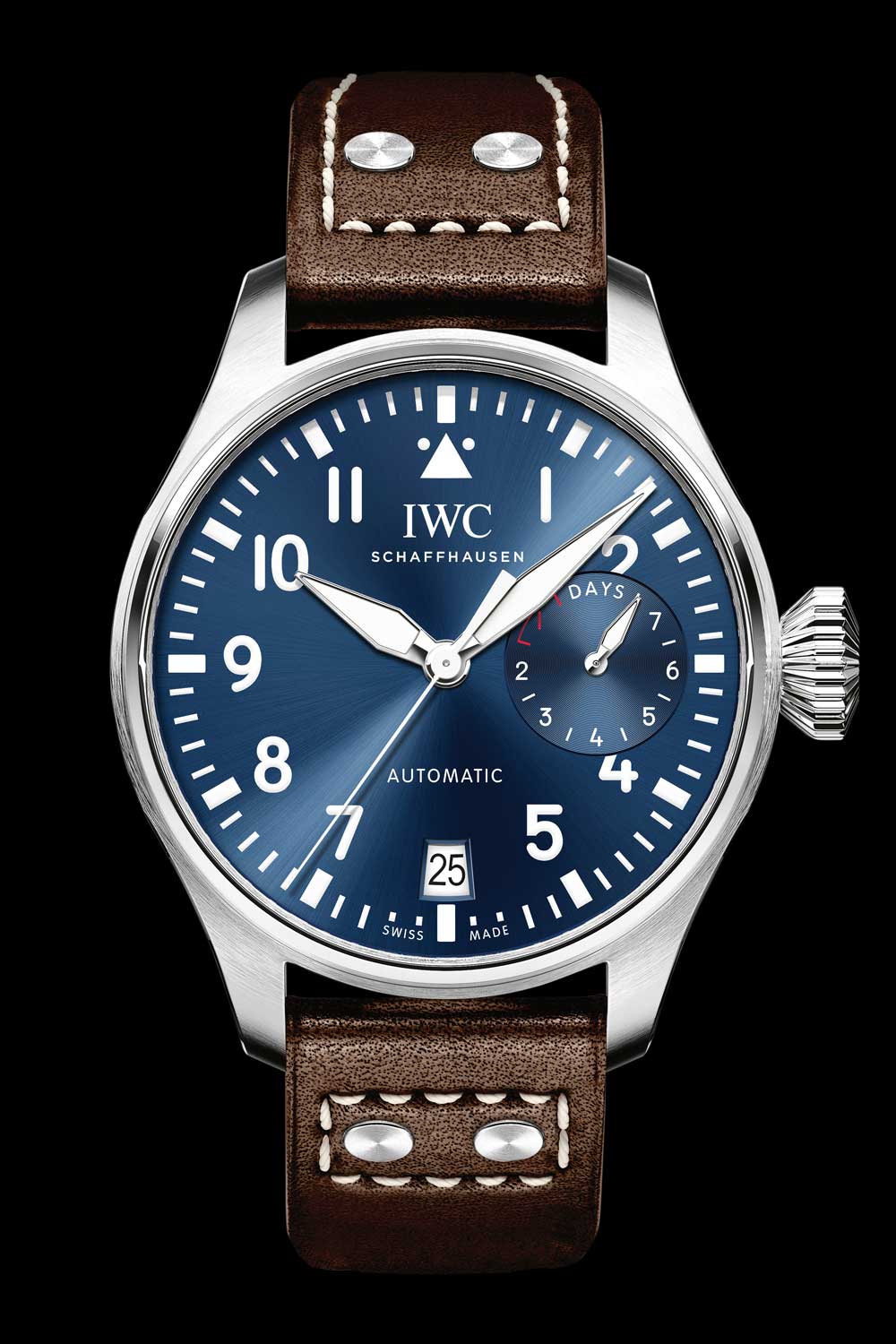
The signature midnight-blue dials of the “Le Petit Prince” collection can be seen in this trio of watches released for this year.

The signature midnight-blue dials of the “Le Petit Prince” collection can be seen in this trio of watches released for this year.
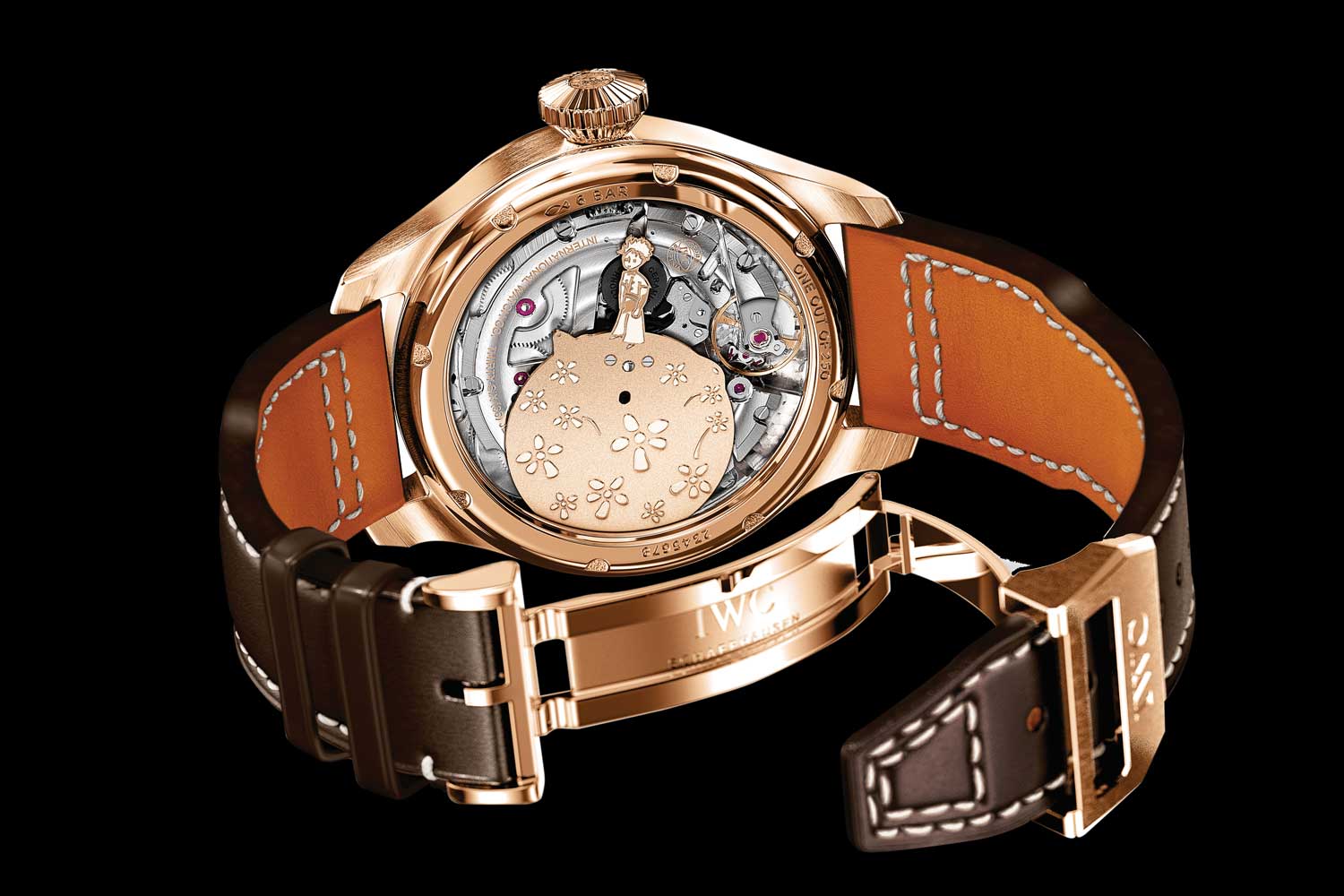
The sapphire caseback of the “Le Petit Prince” Big Pilot with solid-gold rotor in the shape of the little prince standing on his asteroid
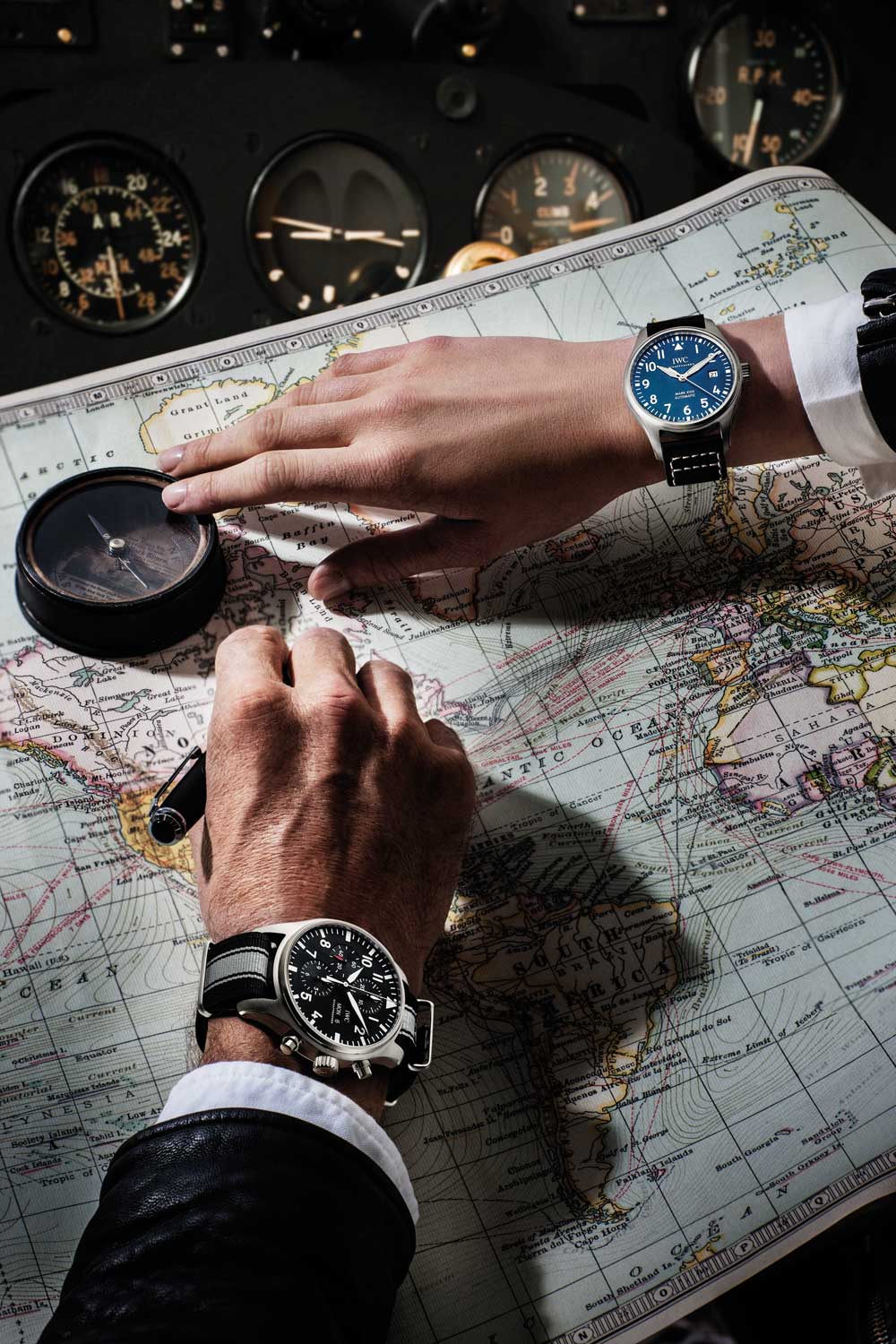
Above: IWC Pilot’s Watch Mark XVIII Edition “Le Petit Prince” in stainless steel with brown calfskin-leather strap. Bottom: IWC Pilot’s Watch Chronograph in stainless steel with black and gray fabric strap.
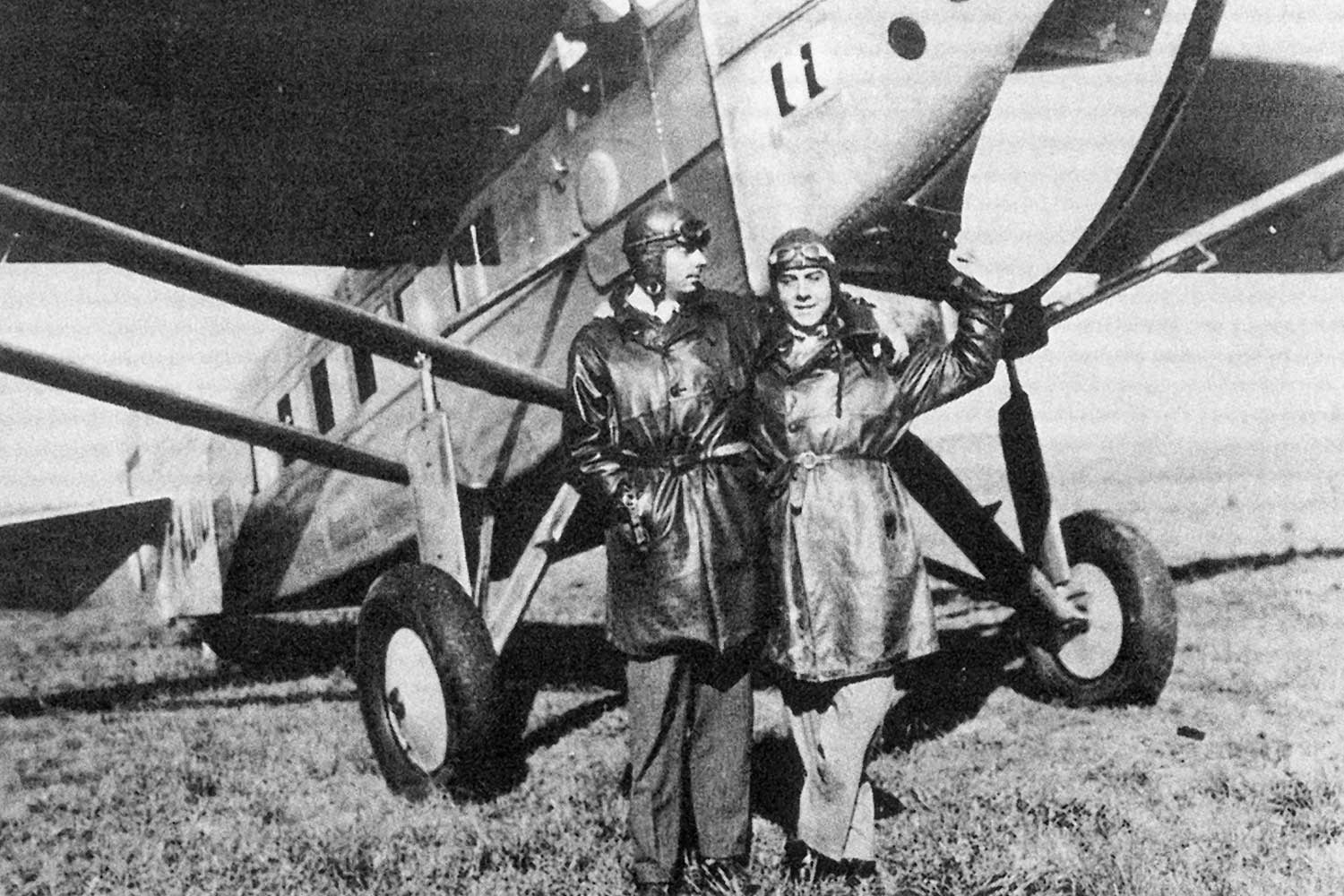
Airmail pilots Antoine de Saint-Exupéry (left) and his friend Henri Guillaumet (right) in Argentina in 1930
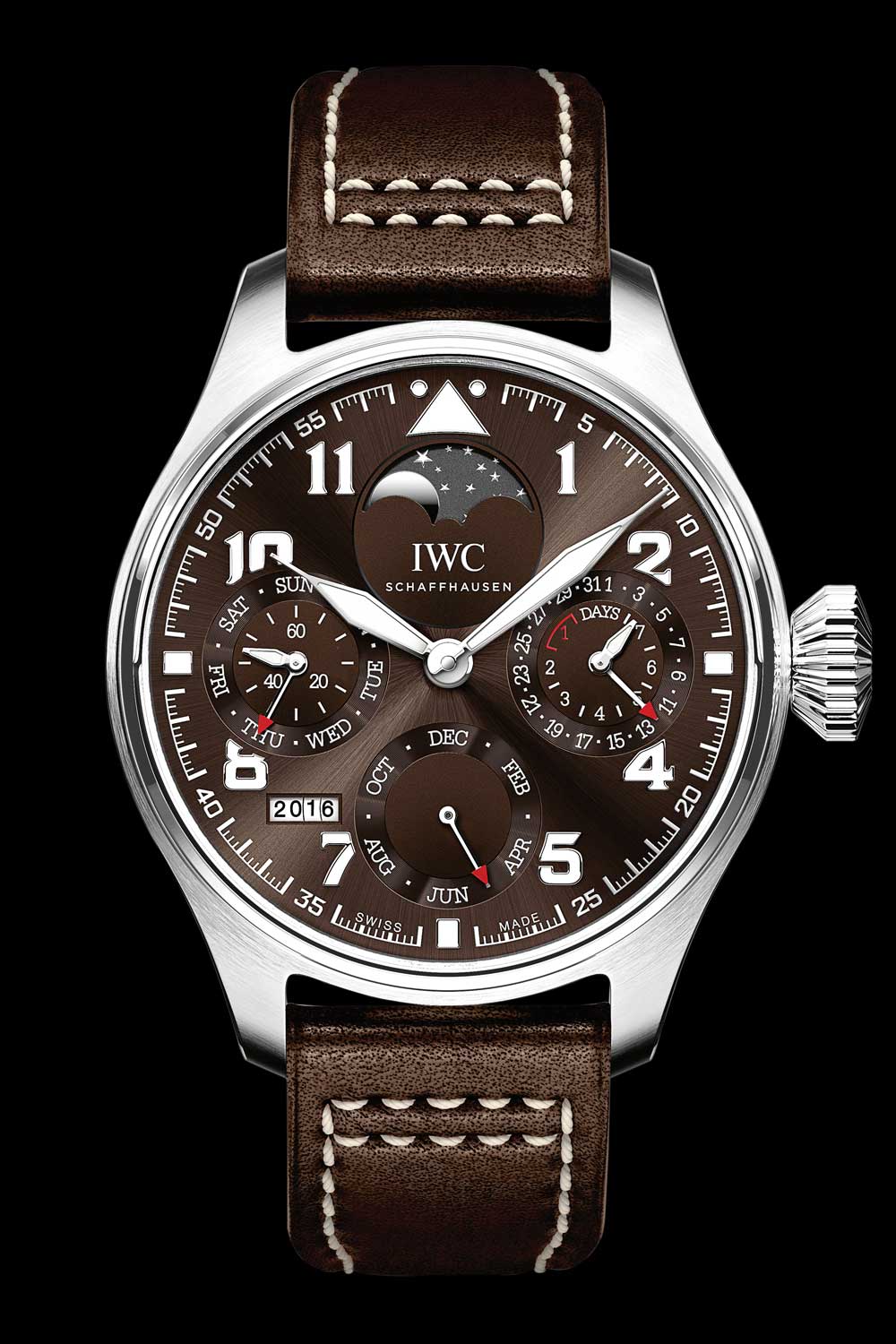
Big Pilot’s Watch Perpetual Calendar Edition “Antoine de Saint Exupéry”
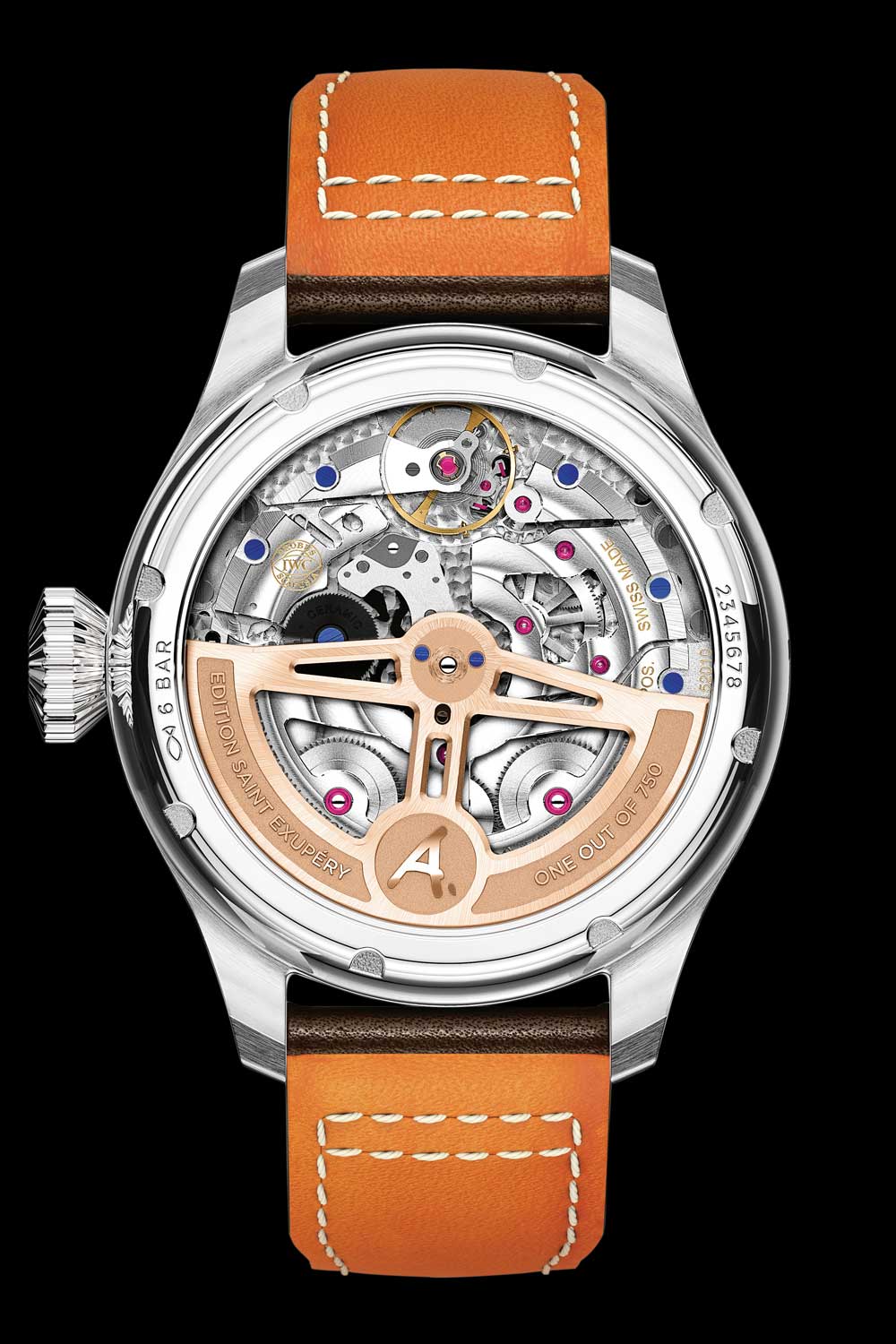
The alphabet “A” (for Antoine) is engraved on its caseback

IWC Pilot’s Watch Automatic 36 in stainless steel with dark-brown alligator-leather strap. Black leather-polyester jacket, white viscose shirt, black calfskin-leather trousers, and black aviators, all property of Revolution
Spitfire
The legendary Spitfire used by the British Royal Air Force came into service in 1938 and was designed as a short-range high-performance interceptor. When it arrived on the scene, it was easily the fastest plane of its era, and quickly became, through its technical capabilities, the backbone of British air superiority during the period of World War II and beyond.
This is the plane that the “Spitfire” pillar of the IWC Pilot’s Watch collection is meant to commemorate, and the resonance is striking, considering the long relationship between IWC and the British Royal Air Force. This is especially made more evident when one considers the legendary Mark 11 and its connection to British aviators, who used this tough, accurate and reliable watch for over 40 years.
The updates to the Spitfire pillar follow the general path of the standard versions of the same watches, with similar design tweaks. In the Spitfire variations, collectors have always been able to find a slightly more elegant presentation of the pilot’s watch, with models distinguished by more polished surfaces on the dial and hands, recalling the shiny unpainted fuselage of the namesake plane.
The new Big Pilot’s Watch Spitfire (IW500917) in 18K red gold is perhaps the most extreme embodiment of this elegance from the Spitfire collection, coming in at 46mm in diameter. Combining the luxurious precious metal with the rugged aesthetic of the Big Pilot, this new watch is certainly an eye-catching piece that will attract attention.
The other update can be found in the Pilot’s Watch Chronograph Spitfire (IW377719), with the same date display update as seen in the standard version, but with a more elegant appeal. This comes from not only the slate-gray dial that is a signature of the Spitfire watches, but also from the bracelet with two rows of polished links in the middle. These features make this version of the Pilot’s Watch Chronograph more versatile, allowing an easy transition from sporty activities to more-formal settings.
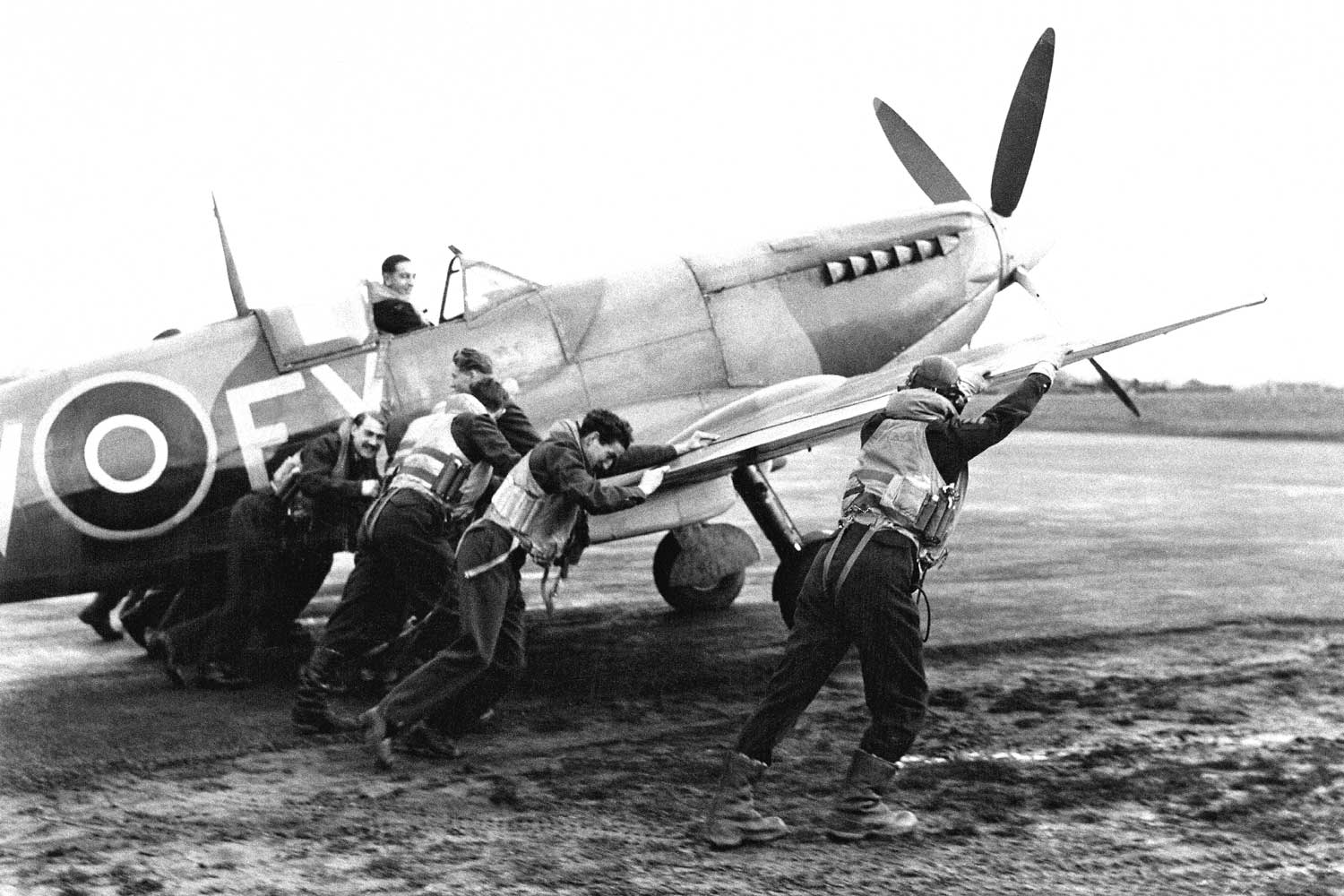
An improved Spitfire is wheeled onto the runway by a group of pilots from the squadron
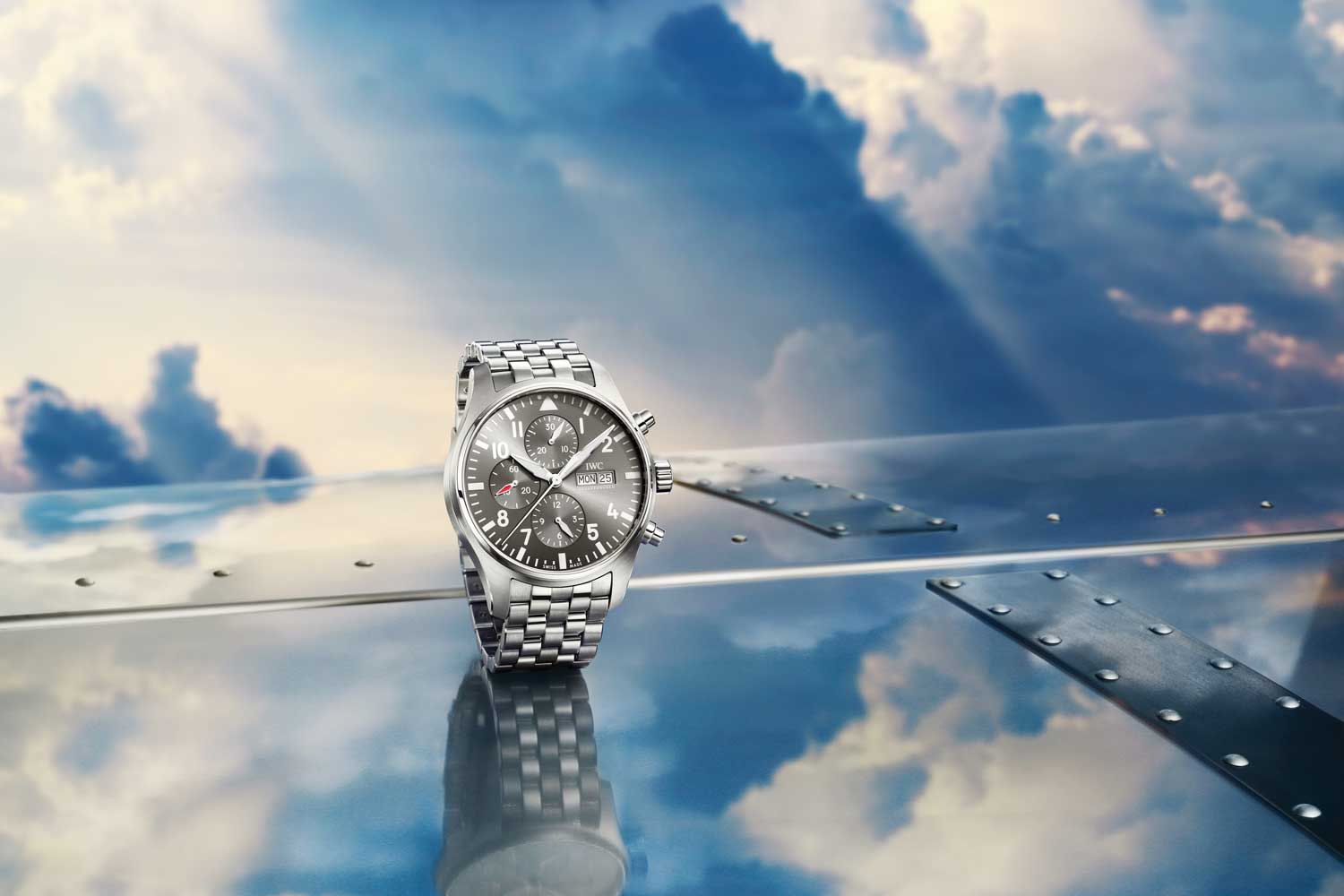
The Spitfire collection sees two new additions to the line, the Pilot’s Chronograph Spitfire on bracelet with slate-gray dial, as well as an 18K-red-gold Big Pilot Spitfire

IWC Big Pilot’s Watch Spitfire in red gold with brown calfskin-leather strap. Brown genuine-leather jacket, Schott NYC; white cotton shirt, navy silk-knit tie and black aviators, all property of Revolution
The Romance of Flight
The IWC Pilot watch is the quintessential classic of our modern times and it accomplished this feat over time by building the best watches for pilots. But there is something more, for no other brand has been as much a part of aviation since its early history than IWC.
While we enjoy the convenience of flying today in our comfortable and pressurized jumbo jets, it is interesting to consider how things must have been like in those early days, when flying was still new, and when many of the things we know today were still being figured out. How much fear must have gone through the minds of those early pioneers, a kind of fear mixed in with a dose of adventure that must have made flying an almost-heroic act.
Add that to the intuitively impossible notion of the act of flying itself, a feeling that comes when the plane we are in breaks the bounds of this earth, and moves through the sky at impossible speed? How many of us have felt a sense of amazement that we could be experiencing this impossible thing?
This, and the fact that flying gives us the freedom to go to faraway places and realize new possibilities, is when we realize that the dream of flight affects us all, no matter who we are.
What is a pilot’s watch then, but a passport to a dream? Strapping one on connects us to the heroic exploits of the pilots of aviation’s history, even as we enjoy the fruits of modern aviation. Perhaps that is why the pilot watch is so popular and well loved, and really, one could not do better than strapping on an IWC Pilot watch.

IWC Big Pilot’s Heritage Watch 48 in titanium with brown calfskin-leather strap. Brown suede double-breasted trench coat, white cotton shirt, navy and white pinstripe trousers, black silk tie, brown cotton scarf, and brown calfskin gloves, all property of Revolution
Photographer: Sidney Teo
Fashion Stylist: Marie Lee
Fashion Assistant: Carissa/Marie Lim
Makeup: Rina Sim using NARS
Hairstyling: Andrea Razali using L’Oreal Professional
Models: Pier L/ Ave & Nikayla / Mannequins










